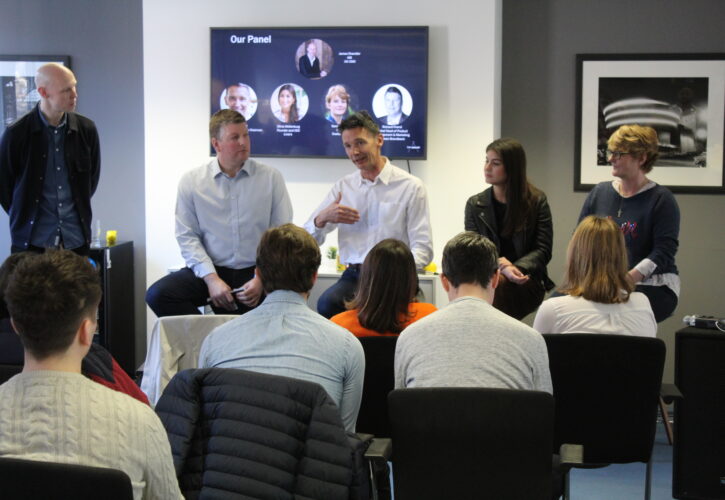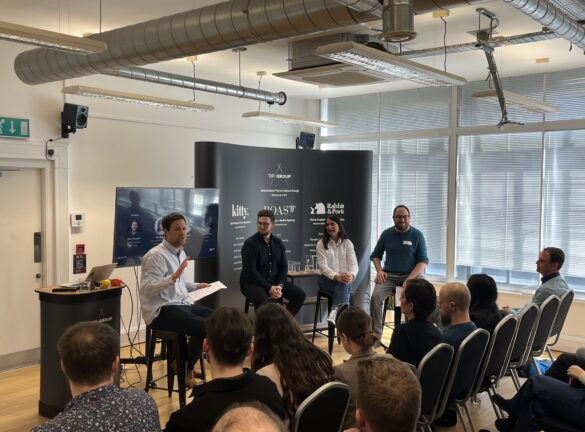
Food for Thought: Key FMCG Insights from TIPi Group and Small Films' Shaping the Future Breakfast
On the morning of 27th of February, we welcomed clients, partners and friends into our Holborn offices for a morning of delicious muesli and equally tasty insights into the FMCG industry. The event, hosted in partnership with Small Films, consisted of three talks and a panel discussion. Read on for five bite-sized insights from each session:
The Search for Truth – Understanding Consumers Using Search Data

Tim Bonney – Strategy Partner, TIPi Group
The challenges faced by FMCG brands
The democratisation of the marketplace is putting increasing pressure on the FMCG market. Consumers are expecting products to be ethical and healthy whilst also being good-value and readily available. For small brands to succeed they must inspire customer loyalty, which all starts with deep understanding of the consumer.
The problem with traditional research methods
The traditional methods of focus groups, field research, surveys and social listening are valuable, but limited by one key factor – everybody lies! Social Desirability Bias, a term coined by Allen L Edwards back in 1950 suggests that even when surveys are anonymous, people over-report on socially desirable behaviours such as giving to charity or voting.
“Trust me, I’m a Search Engine”
Google has become a confidant, a therapist, a doctor. It’s where we ask the questions that we’re too embarrassed to ask to even our closest friends or family. We asked you, “If you had a gun to your head, which of the following would you provide to a complete stranger? Access to your Facebook feed, your Google search history, or a chance to rifle through your drawers. Only 8% opted to give away your search history.
Reverse-engineering Google’s algorithms to unlock insights
Our Search Intent tool maps changes in language across the path to purchase and assesses what types of results Google serves at each point. This exposes key areas where brands need to serve consumer needs. It can inform which sites we place ads on, at what time we have them running, and which format we have them in
The role of Search Insights
The inherent truthfulness of Search Insights affords them a unique position when it comes to bolstering your insights arsenal. Accurate and instantly actionable, the learnings that we take from Search can be used to support your paid, earned and owned media planning.
Voice Experience – The Role of Voice for FMCG brands

Daphne Xenakis, Voice Search Manager, Rabbit & Pork
The Voice Assistant in your pocket
Voice is about more than just smart speakers, almost all smartphones have a voice assistant built in. Interacting with your phone using voice helps initiate people to voice-led interactions, making them more comfortable talking to machines.
A voice-enabled world
Over the past year Amazon and Google have both opened up their system so that other manufacturers can make voice-enabled products with Amazon and Google technology built in. This has led to a tidal-wave of new inventions, with voice-enabled watches, mirrors, bins, cars and furbies bursting onto the scene.
FMCG brands are already embracing Voice
Ocado is encouraging people to adopt new routines with their Action that allows you to add items to your basket with your voice, Johnnie Walker has created a “Guided Tasting” voice experience encourages consumers to engage with the brand, and Quaker made an action which inspired loyal customers to try new “overnight oats” recipes.
Beware potential pitfalls
With emerging technologies, there are always potential pitfalls. Voice Assistants have improved dramatically over the past few years, but they still occasionally mishear queries and give wrong answers. It’s crucial to ensure that your Action or Skill is pulling from a secure data source, otherwise you might have a Burger King situation on your hands.
It all starts with a use-case
Using Rabbit & Pork’s Hackathon winning skill as an example, Daphne took us through the process of building an Action and Skill. Starting off with looking at search trends and volumes to find a use case, through to writing the code, mapping conversation paths, and continually expanding the Voice experience.
The Rise of Video

George Hughes – Founder/ Creative Director, Small Films
An ever-growing opportunity
50% of Millennials no longer using traditional TV platforms, and by 2020 it’s predicted that we will be spending an average of 84 minutes a day watching videos online. As consumers make this transition to digital advertisers are following suit, and over the past year online video has been the fastest growing digital ad format, with spend increasing by 40%.
The dangers of over-saturation
The downside to the rapid growth of online video is that consumers are becoming increasingly unreceptive as they’re bombarded by messaging. Smart strategy and slick creative are needed to help brands to cut through the noise and make themselves heard.
The benefits of storytelling
Video is versatile and engaging, and most importantly it allows brands to tell their story. FMCG brands have an unrivalled opportunity with millennials, where engagement around food is particularly high. Studies show that 80% of millennials want to “see the story behind the scenes” of how their food is made.
An audience-first approach to thumb-stopping content
With the average Facebook user scrolling through 300 feet of feed every day the only way to stop the scrolling and resonate with your customers is to have an in-depth knowledge of who you are trying to connect with. Take for example, Knorr, they surveyed over 12,000 people then ran an online “Flavour Profiler” to inform a video that really resonated with millennials, it won them 1.6 billion free impressions.
The future of video
Video is a continuously evolving format, and in the near future we expect changes in how videos are hosted, discovered and watched. Firstly, we predict that more brands will follow in the footsteps of trailblazers like Redbull to become publishers in their own right. Secondly, we expect Google’s Video Search feature to become more widely used, changing the way we find content. Thirdly, the advances being made in AR and VR are likely to make consuming video a more interactive experience.
Food for Thought – Panel Discussion

Chair: James Chandler, UK CMO, IAB
Guests (left to right):
Richard Friend, Global Head of Product, Management & Marketing, Nielsen Brandbank.
Nick Barnard, Co-founder and executive Chairman, Rude Health.
Olivia Wollenburg, Founder and CEO, Livia’s.
Sarah Sleet, CEO, Coeliac UK.
Transparency, trust and integrity
As consumer-consciousness of topical issues such as microplastics and palm oil grows, brands are being challenged to be more transparent than ever before. In the race for consumer trust the big, long-established brands with a history of opacity are struggling to keep pace with their younger, more agile competitors, who have been built with transparency and accountability at the centre of their brand ethos.
Futureproofing brands by building sustainable relationships
Building personal relationships with consumers by communicating brand messages across multiple physical and digital touchpoints has become the bread and butter of FMCG brand building. Whether it’s communication through packaging, brand experiences, or social channels, consistent messaging to build brand advocacy is crucial in this age of saturated categories and dwindling brand loyalty.
Instagram as a brand-building platform
Instagram’s growth shows no sign of slowing down. Despite increasing backlash over the way it handles potentially dangerous content, and allegations that it has become flooded by bots, its user base has steadily grown to over one billion monthly active users. For FMCG brands Instagram can be a godsend; it’s a hotbed of engagement where a loyal followers can be crucial to a challenger brand’s success. It gives consumers the chance to buy into the product narrative: who it’s being made by, how they’re making it, and, perhaps most importantly, why they’re making it.
Cross-category disruption
If you’ve got brand-purpose and a strong identity, there’s no need to be constrained by the traditional FMCG categories. The journey of Rude Health from making only muesli to producing a range of products from snacks to drinks to flour, and the similar progression of Livia’s, which started out making only crumbles and now makes an expansive range of naturally free-from treats, show that brands with loyal followings can now stride across category lines.
Data, technology, and safety
So many claims are being made in the FMCG space that it can sometimes be hard to separate fact from fiction. When people need to avoid certain ingredients for medical reasons accurate data, which is currently surprisingly hard to come by in UK supermarkets, is of paramount importance. Once the data is right, new technologies such as voice can be introduced to bring that data to life, allowing consumers to access it in a format that is accessible and engaging.






